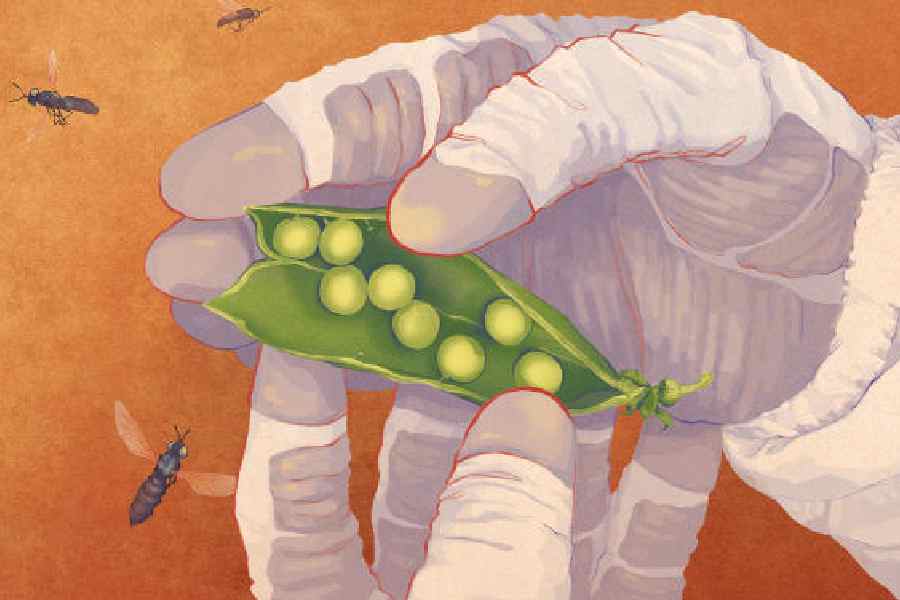At first it was just one flower, but Emmanuel Mendoza, an undergraduate student at Texas A&M University, US, had worked hard to help it bloom. When this five-petaled thing burst forth from his English pea plant collection in late October, and then more flowers and even pea pods followed, he could also see, a little better, the future it might foretell on another world millions of miles from Earth.
These weren’t just any pea plants. Some were grown in soil meant to mimic Mars’ inhospitable regolith, the mixture of grainy, eroded rocks and minerals that covers the planet’s surface. To that simulated regolith, Mendoza had added fertiliser called frass — the waste left after black soldier fly larvae are finished eating and digesting. Essentially, bug manure.
The goal for Mendoza and his collaborators was to investigate whether frass and the bugs that created it might someday help astronauts grow food and manage waste on Mars. Black soldier fly larvae could consumeastronauts’ organic waste and process it into frass, which could be used asfertiliser to coax plantsout of alien soil. Humans could eat the plants, and even food made from the larvae, producing more waste for the cycle to continue.
While that might not ultimately be the way astronauts grow food on Mars, they will have to grow food. “We can’t take everything with us,” said Lisa Carnell, director for Nasa’s Bio-logical and Physical Sciences Division.
But gardening doesn’t just require a plot of land, a bit of water, a beam of sunlight. It also requires very animate ingredients: the insects, like black soldier flies, and microorganisms that keep these ecological systems in working order. A trip to Mars will also involve creeping, crawling carry-ons most people don’t think about when they envision brave explorers stepping foot on new worlds.
Space travellers haven’t yet gone very far for very long.
“Currently, when you’re going into space, it’s more like going on a prolonged camping trip,” said Scott Parazynski, a former Nasa astronaut who spent nearly two months in space. Astronauts bring freeze-dried food (and flavour enhancers like hot sauce). If they’re on the International Space Station, they might get to look at, but rarely consume, fresh greens from an experimental lettuce plot.
To stay for an extended time on the surface of Mars, though, astronauts won’t be able to rely on their space pantries. They’ll needMartian gardens. And Martian gardens will need alittle help — maybe from black soldier fly larvae and their excretions.
“They’re very voracious eaters,” said Hellen Elissen, a researcher at Wageningen University and Research in the Netherlands. “They eat almost anything.” And if you feed them well, they’ll make a lot of frass.
In the past five or 10 years, scientists have started to use that frass — rich in nitrogen, potassium, phosphorous and also bacteria — as fertiliser. The material also contains chitin, from the insects’ bodies, and leftover organic matter. Elissen recently published a review article about how frass affects plants and soil, and one of her main takeaways was that the value of the insects’ waste coincides with the value of their food. Grass? Frass suffers. Give the larvae higher-energy food scraps? Jackpot.
Jeffery Tomberlin, an entomology professor at Texas A&M University, US, knows this well after 25 years of studying black soldier flies. And he’s recruited others to his cause. A graduate student, Noah Lemke, for instance, arrived at Texas A&M to research black soldier flies’ reproductive behaviour. Through the university’s Aggie Research Program, which lets graduate students recruit undergraduates for specific projects, he met Mendoza, an aerospace engineering major who had tried to grow radishes in simulated Martian soil in high school.
“His project header was ‘Black soldier flies can feed the world, but we need more of them’,” Mendoza said. Mendoza thought maybe the flies could, instead, help feed another world.
Soon the idea for a whole system came together. The larvae could eat astronauts’ food waste and produce frass to fertilisebad alien soil, which could then produce food plants. Then the larvae themselves could be ground into a protein source, which astronauts — or animals they might bring along — could consume. “You have this system where humans are feeding the flies, the flies are feeding the plants and animals, the plants and animals are feeding the humans,” Mendoza said.
They decided to test frass’s fertilising capabilities on English peas, planted in simulated Martian soil.
Tomberlin was initially skeptical.
“When they came to me and said, ‘Hey, we want to get Martian soil,’ I waslike, ‘Where did you getMartian soil?’” he said. “They’re like, ‘Oh, no, we’ve got a supplier.’”
It was the Martian Garden, a company based in Texas, US.
Simulated regolith in hand, the trio mixed the frass with the simulated Martian soil in different proportions, to see how the peas liked it. In a pilot experiment, those combinations ranged from zero frass and all regolith to all frass and no regolith, covering percentages in between. The group then compared those plants’ growth to that of greenery ensconced in consumer plant soil, also fertilised with various frass proportions. After that trial, they shrank the range, trying frass percentages from zero to 50.
“The peas perform similarly in both Martian soil and potting mix,” Lemke said, at least if the conditions are right.
Mendoza recently presented the trio’s results at the Entomological Society of America conference, and he hopes to use his engineering background to begin work on a physical system that could actually be used in space exploration, keeping the insects contained and productive far from their terrestrial home.
NYTNS










